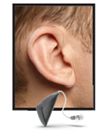Hearing Aid Styles
Many choices of hearing aid styles are available, including the following: completely- in-the-canal, in-the-canal, in-the-ear, behind-the-ear, receiver-in-canal or receiver- in-the-ear, and open fit. Your audiologist will help you decide which style is right for you based on your specific needs and preferences.
Completely-in-the-canal (CIC) or mini CIC
A completely-in-the-canal hearing aid is molded to fit deep inside your ear canal. It improves mild to moderate hearing loss in adults.
A completely-in-the-canal hearing aid:

- Is the smallest and least visible type of hearing aid
- Is less likely to pick up wind noise
- Uses very small batteries, which have a shorter life and can be difficult to handle
- Doesn't contain extra features, such as volume control or a directional microphone
- Is more difficult to manage for people with dexterity issues
- Is susceptible to earwax clogging
In-the-canal
An in-the-canal (ITC) hearing aid is custom molded and fits partly in the ear canal. This style can improve mild to moderate hearing loss in adults.
 An in-the-canal hearing aid:
An in-the-canal hearing aid:
- Is less visible in the ear than larger styles
- Includes features that won't fit on completely-in-the-canal aids, but may be difficult to adjust due to its small size
- Is susceptible to earwax clogging
In-the-ear
An in-the-ear (ITE) hearing aid is custom made in two styles -- one that fills most of the bowl-shaped area of your outer ear (full shell) and one that fills only the lower part (half shell). Both are helpful for people with mild to severe hearing loss.
 An in-the-ear hearing aid:
An in-the-ear hearing aid:
- Includes features such as volume control and directional microphones that are easier to adjust
- Is generally easier to insert
- Uses larger batteries, which are easier to handle and last longer
- Is susceptible to earwax clogging
- May pick up more wind noise than smaller devices
- Is more visible in the ear than smaller devices
Behind-the-ear
A behind-the-ear (BTE) hearing aid hooks over the top of your ear and rests behind the ear. A tube connects the hearing aid to a custom earpiece called an earmold, which fits in your ear canal. This type of hearing aid is appropriate for people of all ages and those with almost any type of hearing loss.

A behind-the-ear hearing aid:
- Traditionally has been the largest type of hearing aid, though some newer mini designs are streamlined and barely visible
- Is capable of more amplification than other styles
- May pick up more wind noise than other styles
- Is more difficult to insert
Receiver-in-canal or receiver-in-the-ear/ Open fit

An open-fit hearing aid is a variation of the behind-the-ear hearing aid. This can be in the form of a receiver-in-the-canal (also known as a receiver-in-the-ear) or a slim tube style. These styles keep the ear canal very open, allowing low-frequency sounds to enter the ear naturally and high-frequency sounds to be amplified through the hearing aid. This makes the style a good choice for people with mild to profound hearing loss. The open-fit behind-the-ear style has become very popular.
The receiver-in-canal (RIC) and receiver-in-the-ear (RITE) styles are similar to a behind-the-ear hearing aid with the speaker or receiver in the canal or in the ear. A tiny wire, rather than tubing, connects the pieces.
The slim tube style of hearing aid is similar to a behind-the- ear hearing aid, with a smaller, less noticeable tube and often a non-custom tip, keeping the hearing aid in the ear.

The open-fit hearing aid:
- Has a less visible behind-the-ear portion
- Is susceptible to earwax clogging
- Doesn't plug the ear like other styles, which makes your own speech sound better to you
- Is difficult to handle due to small parts and batteries
- Often lacks manual adjustments due to its small size
Photos courtesy of Oticon Canada Ltd.
.svg?iar=0&hash=F6049510E33E4E6D8196C26CCC0A64A4)

/hfh-logo-main--white.svg?iar=0&hash=ED491CBFADFB7670FAE94559C98D7798)